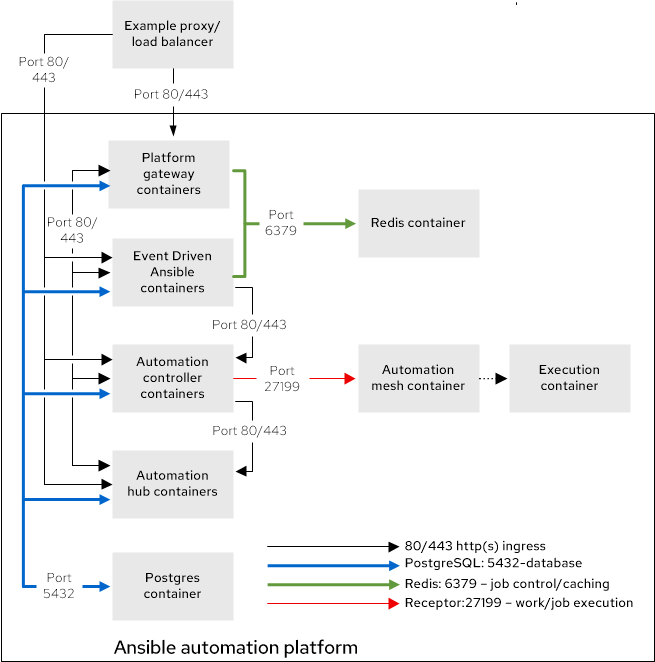第 3 章 容器名称
Ansible Automation Platform 为容器化 Ansible Automation Platform 提供经过测试的拓扑。选择最适合您基于容器的部署要求的拓扑。
3.1. 容器增长拓扑
基于容器的增长拓扑为开始使用 Ansible Automation Platform 的机构提供较小的占用空间部署,而无需冗余。包括经过测试的基础架构拓扑、系统要求、网络端口配置和示例清单文件,用于安装。
3.1.1. 基础架构拓扑
此部署模型的红帽测试的基础架构拓扑:
图 3.1. 基础架构拓扑图
红帽根据以下要求测试单个虚拟机:
| 要求 | 最低要求 |
|---|---|
| RAM | 16 GB |
| CPU | 4 |
| 本地磁盘 |
|
| 磁盘 IOPS | 3000 |
如果使用 hub_seed_collections=true 执行捆绑的增长拓扑安装,则建议使用 32 GB RAM。使用这个配置,安装时间将增加。请参阅集合可能需要 45 分钟或更长时间。
| 用途 | 组名称示例 |
|---|---|
| 所有 Ansible Automation Platform 组件 |
|
3.1.2. 测试的系统配置
红帽已测试了这些配置来安装和运行 Red Hat Ansible Automation Platform:
| 类型 | 描述 | 注 |
|---|---|---|
| 订阅 |
| |
| 操作系统 |
| |
| CPU 架构 | x86_64, AArch64, s390x (IBM Z), ppc64le (IBM Power) | |
|
|
|
|
| 浏览器 | 当前支持的 Mozilla Firefox 或 Google Chrome 版本。 | |
| 数据库 | PostgreSQL 15 | 外部(客户支持)数据库需要 Unicode (ICU)支持国际组件。 |
3.1.3. 网络端口
Red Hat Ansible Automation Platform 使用多个端口与其服务进行通信。这些端口必须处于打开状态,并可用于 Red Hat Ansible Automation Platform。确保这些端口可用,且防火墙不会阻止。
| 端口号 | 协议 | 服务 | Source | 目的地 | 描述 |
|---|---|---|---|---|---|
| 80/443 | TCP | HTTP/HTTPS | Event-Driven Ansible | Automation hub | 拉取容器决策环境 |
| 80/443 | TCP | HTTP/HTTPS | Event-Driven Ansible | 自动化控制器 | 启动自动化控制器作业 |
| 80/443 | TCP | HTTP/HTTPS | 自动化控制器 | Automation hub | 拉取集合和执行环境镜像 |
| 80/443 | TCP | HTTP/HTTPS | 平台网关 | 自动化控制器 | 自动化控制器通信的平台网关 |
| 80/443 | TCP | HTTP/HTTPS | 平台网关 | Automation hub | 到自动化 hub 通信的平台网关 |
| 80/443 | TCP | HTTP/HTTPS | 平台网关 | Event-Driven Ansible | 到 Event-Driven Ansible 通信的平台网关 |
| 5432 | TCP | PostgreSQL | Event-Driven Ansible | 数据库 | 事件驱动 Ansible 数据库访问 |
| 5432 | TCP | PostgreSQL | 平台网关 | 数据库 | 平台网关数据库访问 |
| 5432 | TCP | PostgreSQL | Automation hub | 数据库 | Automation hub 数据库访问 |
| 5432 | TCP | PostgreSQL | 自动化控制器 | 数据库 | 自动化控制器数据库访问 |
| 6379 | TCP | Redis | Event-Driven Ansible | Redis 容器 | 用于 Event-Driven Ansible 的作业启动和数据存储 |
| 6379 | TCP | Redis | 平台网关 | Redis 容器 | 平台网关服务的数据存储和检索 |
| 8443 | TCP | HTTPS | 平台网关 | 平台网关 | 内部网关 NGINX 通信 |
| 27199 | TCP | Receptor | 自动化控制器 | 执行容器 | Mesh 节点直接连接到控制器。允许作业分发的双向通信。 |
| 8080/8443 | TCP | HTTP/HTTPS | 平台网关 | 自动化控制器 |
自动化控制器 NGINX 端口。您可以使用以下清单变量配置这些端口: |
| 8081/8444 | TCP | HTTP/HTTPS | 平台网关 | Automation hub |
自动化中心 NGINX 端口。您可以使用以下清单变量配置这些端口: |
| 8082/8445 | TCP | HTTP/HTTPS | 平台网关 | Event-Driven Ansible |
event-Driven Ansible NGINX 端口。您可以使用以下清单变量配置这些端口: |
| 8083/8446 | TCP | HTTP/HTTPS | 平台网关 | 平台网关 |
平台网关 NGINX 端口。您可以使用以下清单变量配置这些端口: |
如果使用清单变量更改任何端口值,请参阅 清单文件变量来查看所有 默认端口值,并确保没有端口冲突。
3.1.4. 清单文件示例
使用示例清单文件执行安装:
只有在远程主机上安装时,才需要 SSH 密钥。如果进行一个基于本地虚拟机的安装,您可以使用 ansible_connection=local。
